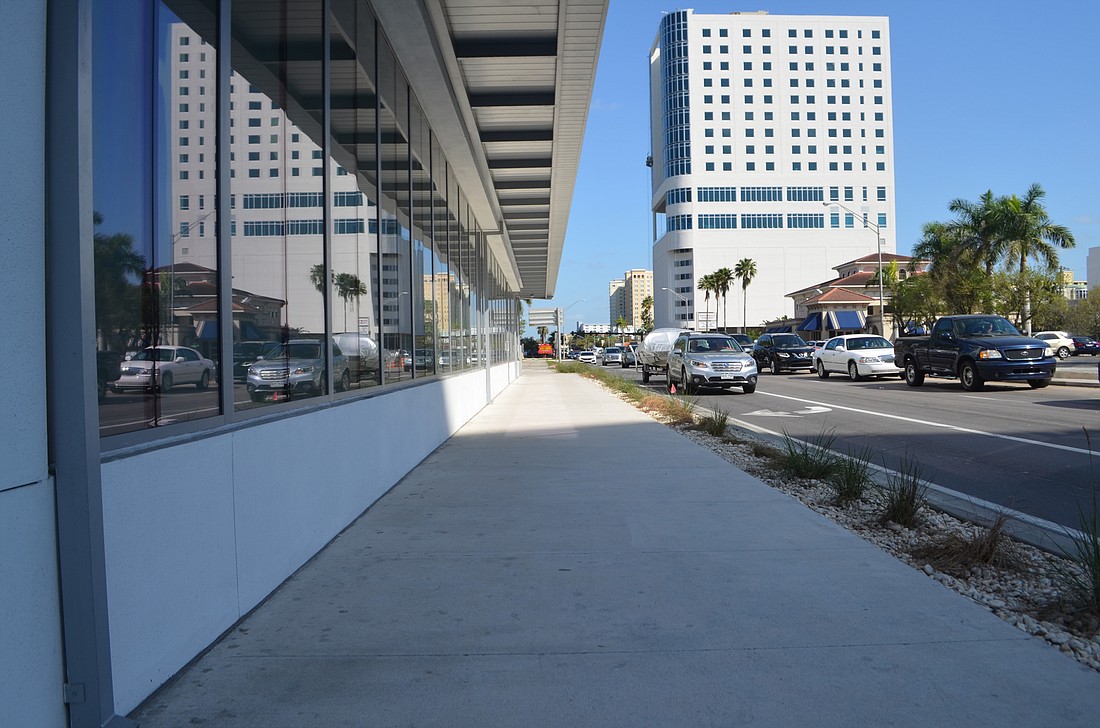- January 6, 2025
-
-
Loading

Loading

City planners largely agree on the biggest challenge to creating a more walkable downtown: a lack of available space.
Residents have recently asked the city to prioritize building wider sidewalks on key pedestrian corridors. It’s a core issue for the resident activist group STOP, which has earned an endorsement from more than a dozen neighborhood and condominium associations.
STOP has identified streets such as Fruitville Road and Tamiami Trail as subpar pedestrian experiences because the sidewalks aren’t wide enough. And city staff generally doesn’t challenge the assertion that the sidewalks should, ideally, be wider.
The problem, staff says, is that these streets aren’t just designed around creating an ideal sidewalk. Dividing the public right of way is a zero-sum game. If you want to add five feet to each sidewalk on a corridor, you’re going to have to take away 10 feet from the roadway or the medians.
As the city prepares to vet a proposed form-based zoning code in 2018, residents and elected officials are curious to see how the new regulations might better facilitate wider sidewalks. The City Commission held a special meeting Feb. 22 to hear how the city’s Urban Design Studio, which is authoring the form-based code, plans to address sidewalks and building setbacks.
A draft of the code is scheduled to be finalized by March 9. In the meantime, Urban Design Studio Director Karin Murphy outlined a few strategies in the code for facilitating a more walkable city.
The recommendations generally seek to maximize the right of way already available to the city. They include narrowing travel lanes, where possible, to reclaim space for pedestrian and bicycle use, as well as better regulating the placement of trees, lightpoles, signs and other sidewalk amenities to manage that public realm as efficiently as possible.
Murphy also intends to include provisions encouraging developers to dedicate a portion of their land as public right of way in exchange for certain incentives, such as increased height or density. For the most part, though, she focused on how to best manage the existing right of way to enhance walkability.
“We’re going to have to set buildings back, or we’re not getting that space.” — Kate Lowman
But STOP is pushing for swifter action outside the context of adopting a whole new zoning code. The group isn’t satisfied making the best of the existing right of way — they pushed the city to move quickly to create more right of way by requiring wider setbacks for all projects.
STOP’s perspective, in essence: If the city’s biggest challenge is a lack of available space, go get more space.
Kate Lowman, a member of STOP’s steering committee, said the group also wanted the city to commit to standards that prioritized and clearly outlined appropriately wide sidewalks for different segments of Sarasota. But the group knows the idea of narrowing roads and reducing the emphasis on vehicular transportation is contentious. For any progress to occur on widening sidewalks, the group thinks there needs to be more land.
“We’re going to have to set buildings back, or we’re not getting that space,” Lowman said.
Perhaps the biggest question about STOP’s proposal is whether the city is legally allowed to pursue it. City Attorney Robert Fournier plans to brief the commission on the subject at a March 5 meeting. Previously, he and Murphy have both expressed concern that requiring a wider setback may represent a taking of a private property right under Florida law.
But even if the city is legally clear to mandate bigger setbacks in areas where property owners can currently build to the lot line, Murphy said that’s not a direct path to wider sidewalks. It’s one thing to ensure that buildings are farther back from the property line, she said. It’s another to actually obtain permission from a private property owner to have the public encroach on their land.
“If we increase the setback on your house, that’s not saying your neighbor can come across your property,” Murphy said.
Murphy said she’s open to a conversation about increasing setbacks and working to widen sidewalks, whether it’s by mandate or through an incentive system. But she cautioned against automatically associating zero-setback construction with an inferior pedestrian experience.
She pointed to retail corridors such as Main Street as an example of how buildings at the property line can actually help make an area more walkable by providing engaging storefronts. And she said setbacks, absent quality standards, can create security issues by breaking up the pedestrians’ line of sight.
Lowman said STOP is waiting for more information from Fournier before delving deeper into a discussion of how to translate wider setbacks into wider sidewalks. Fournier declined to comment on the subject ahead of the March 5 meeting.
Depending on what the city attorney says, Lowman said the city should be prepared to have a conversation about what compensation residents are willing to provide property owners in exchange for wider sidewalks. She said there’s no reason to conclude that’s the direction the discussion will go in, but she said there needs to be an acknowledgement of how resonant the issue of wider sidewalks has been with the public.
“We welcome the conversation,” Lowman said. “It’s a sign that we’re moving beyond generalities and getting serious about how to fix the problem.”